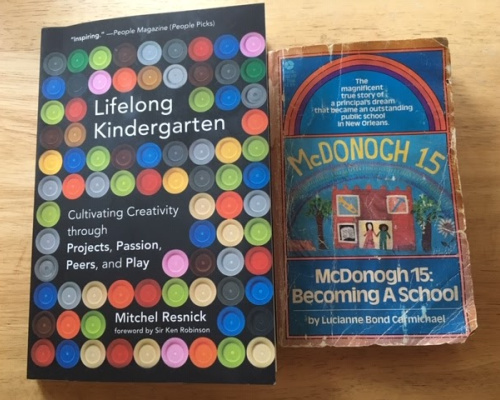A Book Club of One
Date
I hold in my hand a tattered little paperback book that still smells a bit like the damp, formerly-flooded New Orleans school library where I found it as a high school student many years ago. As someone whose military family moved umpteen times—from childhood through adulthood—I have very few books from my youth. McDonough 15: Becoming a School (published 1981), in all its yellow-paged, rainbow-covered glory, is perhaps one of three that I have carried with me throughout the years. It is prominently displayed in my home office because it reminds me of what first inspired my own drive to affect change in education and the lives of children. Even in high school, I knew schools could be reimagined.
The tale of McDonough 15 is an underdog tale. It was a New Orleans public school that "'...had kids nobody cared about. It was the ‘innovative’ school everybody talked about but nobody believed in.'” In this story of “becoming a school,” author and then-principal Lucianne Bond Carmichael recounts her journey of helping build a school firmly rooted in a child-centered curriculum where experience-based learning was an everyday focus and a culture of caring was paramount. I did not attend this school, but I remember a tour as the book describes; children building and making things, murals on the walls, gardens in the courtyard, and grounds replete with chickens, rabbits, and even a goat! Granted, I’m sure it wasn’t all sunshine and rainbows (as the cover suggests) and it can be all-to-easy to romanticize a seeming success story from the past, but this school was different. And different is inspiring.
I imagine a contemporary reading of this tale, and data from the time might reveal a myriad of false assumptions, unconscious bias, or possibly white saviorism, as well as significant failures. Yet this story of children becoming empowered through learning and creation changed the course of my career.
Book Club Revelations
This nostalgic revisiting of a book from my past was prompted by a discussion of a book I am currently reading. At Clarity Innovations, my book club cohort is reading Lifelong Kindergarten: Cultivating Creativity through Projects, Passion, Peers, and Play by Mitchel Resnick (2017). The basic thesis is that creative learning occurs when children are empowered to work on projects based on their passions, with their peers, through exploration and play. The text draws largely from Resnick’s work at the MIT Media Lab where he and his colleagues create and research new technologies designed to help students design, create, explore, and express who they are, what they care about, and what they are learning to do.
As much as we are learning from the book, we are also learning from and about each other. Our small group spans a few generations and several different roles at Clarity. One of our team members is a parent with three young children at home. She described the joy of discovery her children experienced throughout the classic incubating and hatching eggs experiment. While this did not perhaps fulfill the book’s definition of a complete project-based learning experience, it was one which she and her family found extremely rewarding.
After we concluded our Zoom meeting, I thought about what I found rewarding as a learner and what initially inspired me to pursue a career in education research and edtech product development. Then I glanced over at my bookshelf and there—tucked among some classic reference texts—was the tattered little McDonough 15: Becoming a School.
Postnote: A Change for the Better
So what happened to McDonough 15? It continued to operate as an arts-focused school until 2006, when Hurricane Katrina hit and left the building uninhabitable. The school was moved from the French Quarter to New Orleans East and reopened as KIPP (Knowledge is Power Program) McDonough creative arts magnet school. Then, in 2017, the school was rechristened as KIPP Ernest “Dutch” Morial after New Orleans’ first African American mayor, instead of the slave-owner McDonough. In the opening ceremony, school board president John Brown Sr. remarked that—unlike his experience growing up—Morial students would be able to relate to and identify with their school’s namesake. Which means that even in 2020, I continue to be inspired by this school.
Read more about Mayor Morial and Morial school here, and watch a video of the Morial school reopening ceremony here.

